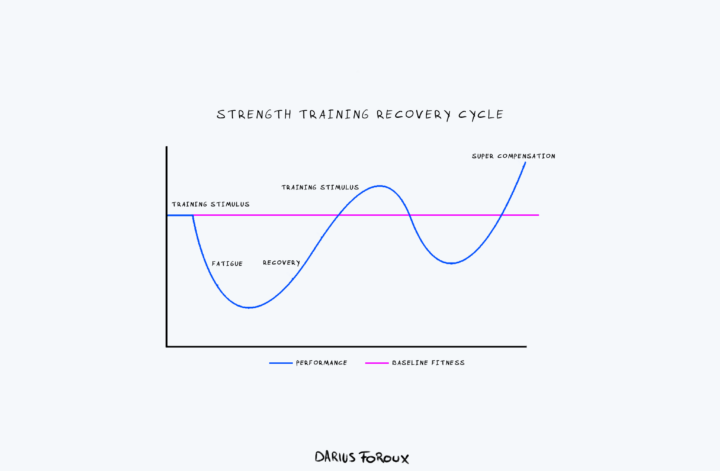Strength training is not just about bulking up or building muscle. As the name implies, it’s about strengthening your body and health.
A common misconception about strength training is that it always leads to “big muscles.”1Source: Triathlete
It really doesn’t happen that fast. Everything depends on your goals. For example, if you want to build lean muscle without adding mass, you moderate your resistance and weights. Then perform a higher number of repetitions instead.
Strength training has been part of my regular exercise routine since I was 15. And I can tell you that it truly improves your mood and energy. You feel so much better and stronger. It’s also good for your sleep and cardiovascular health.2Source: Healthline
From what I’ve seen, people who don’t experience the benefits of strength training are either doing too much of it or not enough. Here’s a very simple routine I’ve been following for the past 20 or so years.
Step 1: Make it very easy to be consistent
I like to keep my workout sustainable. One reason folks give up their workout is because life or work gets in the way. They suddenly get busy at work, or some emergency happens at home, and they end up not doing a workout for weeks. Because there’s “no time.”
So I make it a point that I can do my routine (or at least half of it) in 15-20 minutes.
Because no matter how busy you are, you can always spare 15-20 minutes for a workout. Whenever you get the urge to scroll your phone, try quickly working out instead!
That aside, I recommend having three workouts a week. You don’t have to lift weights every day. If you can’t go three times, stick to two times a week, especially if you do endurance training on other days. (But never just once a week. One workout is not enough).
Figure out what works best for you. Set a time and day when you’ll do your workout. And commit to it no matter what happens.
Step 2: Decide what split/routine you will do
You can divide your routine to concentrate on certain areas of your body.
- 2 workouts a week: One day is for the upper body workout. The other day is for the lower body. I recommend keeping two to three days of rest in between workouts.
- 3 workouts a week: Day 1 can focus on push motions for your chest and triceps. Day 2 focuses on pull motions, for your back and biceps. Then Day 3 can purely focus on legs. Keep one or two days of rest in between workouts.
By splitting your workout accordingly, you let your body recover while maintaining other exercises.
Step 3: Do these exercises for each major body part
People often have problems with the major muscles. So focus on those first. You can concentrate on the following parts:
- Chest: I recommend two main exercises. First is the bench press. Then the cable flies. If you don’t have access to a gym, you can do push-ups instead of a bench press. And get some good dumbbells to use at home as an alternative to cable flies.
- Back: Pretty basic workouts like pull-ups, chin-ups, and, if you’re in the gym, sitting cable rows.
- Legs: Squats, deadlifts, kettlebell swings.
- Shoulders, biceps, triceps, calves: Two to three exercises are enough for each muscle. You can add a few extra exercises for smaller muscles like shoulders (on push day) and calves (on leg day). curls, calf raises, etc.
For a 30-minute routine, you can do three sets of 12 to 15 repetitions. You can do a bit more if you have the time. I generally work out for 45 minutes. More than that is not necessary.
Step 4: Eat a good amount of protein
If you start lifting weights, you’ll need to eat more protein. How much protein do you need?
You can do the following formula: a x b = c.3Source: Very Well Mind
- a is your weight in kilograms (kg)
- b is the grams of protein per kg you need. To determine your “b,” it’s best to consult a healthcare professional. But generally, you can use the low end of 0.8kg if you’re in good health but don’t exercise much. Or use a higher number like 1.2g to 2.0g per kg if you’re under stress, recovering from an illness or injury, involved in intense weight or endurance training, pregnant, or if you’re older.4Source: MDPI
- c tells the ideal amount of protein you should eat per day
For example, a male weighing 154 pounds who exercises regularly and lifts weights, but is not training at an elite level, can aim for 1.7g of protein per kg of body weight.
That would be 154 lbs / 2.2 = 70kg (a); 70kg (a) X 1.7 (b) = 119 grams of protein needed per day (c).
I maintain my protein by eating eggs every day and having a sort of protein food in my dinner. I don’t like protein powder, so I prefer to eat egg whites instead.
30-40% of my biggest meals are also protein-rich. If it’s available in your area, I also recommend eating the Icelandic yogurt called Skyr. It’s pretty high in protein.
Lifting is about consistency
Consistency truly is key to building strength. Strength training is not a quick fix. With consistent effort and a well-planned training program, progress and gains will come.
It’s important to remember that results will not happen overnight. Rather, those who consistently show up and put in the work will see rewards over time.
Whether it’s committing to a certain number of strength training sessions per week or focusing on progressive overload, consistency is the foundation upon which strength gains are built.




